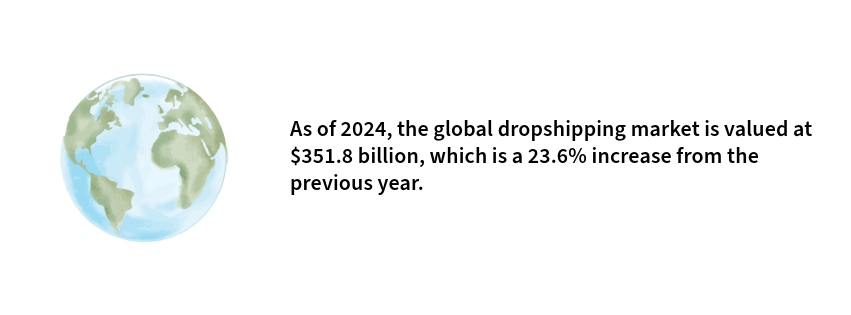How to Start a Successful Dropshipping Store

Take back your time, for little risk.
Dropshipping has become one of the most popular ways to start an online business. It allows entrepreneurs to sell products without the need to hold inventory, manage logistics, or deal with upfront costs. In this comprehensive guide, we’ll walk you through the steps to start your own dropshipping business, from understanding the basics to choosing the right tools to help you succeed. Whether you’re a seasoned entrepreneur or a complete beginner, this guide will provide the value you need to get started.
What is Dropshipping?
Dropshipping is a retail fulfillment method where a store doesn’t keep the products it sells in stock. Therefore, when a store sells a product, it purchases the item from a third party and has it shipped directly to the customer. As a result, the seller doesn’t have to handle the product directly.
Benefits of Dropshipping
- Low Startup Costs: You don’t need to invest in inventory upfront, reducing financial risk.
- Easy to Get Started: With no need to manage physical products, you can focus on marketing and customer service.
- Scalability: As your business grows, you can easily scale up your operations without the hassle of managing more stock.
How to start Dropshipping?
There are many ways to begin Dropshipping. In this simple Dropship Beginners Guide, we will summarize one way to get started and offer some tools that have helped us scale our dropshipping businesses.
1. Choose Your Niche
Embarking on the journey of building a profitable drop shipping business starts with one crucial step: choosing your niche. The phrase “riches in the niches” might sound like a catchy slogan, but it’s much more than that. It’s a guiding principle that can significantly impact the success of your business.
Your niche represents the specific category of products that you’ll be offering to your customers. Selecting the right niche is a balancing act—aim for a category that isn’t overly broad, which could dilute your brand and confuse your target audience, but also avoid a niche so narrow that it lacks a substantial market. Striking the perfect balance will set the foundation for a thriving drop shipping venture.
Tips for Choosing a Niche:
- Passion and Interest: Choose something you are genuinely interested in. It will be easier to stay motivated when there is a difficult moment.
- Market Demand: Research what is currently trending. What are people interested in?
- Profitability: Research whether the niche can offer a good profit margin. Products with a selling price between $20 and $100 often work well.
Examples: Home and Garden Niche, Fashion Niche, Gadgets Niche, Pet Products, Coffee Mugs.
2. Conduct Market Research
Conducting In-Depth Market Research: The Key to Dropshipping Success
After you’ve carefully selected your niche, the next critical step in launching a thriving drop shipping business is to dive deep into market research. This phase is all about gaining a comprehensive understanding of your target audience, competitors, and overall market landscape. With this knowledge, you can strategically position your store to meet the needs of your customers and stand out from the competition. Market research is not just about gathering data—it’s about interpreting that data to make informed decisions that will guide your business toward success.
In this expanded guide, we’ll explore the importance of market research and introduce powerful tools that can help you gather the insights needed to fine-tune your drop shipping strategy.
Why Market Research Is Essential
Market research is the backbone of any successful business strategy. It allows you to get inside the minds of your potential customers, understand their needs, desires, and pain points, and uncover opportunities that your competitors might be missing. By knowing your market inside and out, you can tailor your product offerings, marketing messages, and customer experience to resonate deeply with your audience. This not only helps you attract more customers but also fosters loyalty and encourages repeat business.
Moreover, understanding your competitors is equally important. By analyzing what other drop shipping stores are doing well (and not so well), you can identify gaps in the market that you can fill, giving you a competitive edge. This research phase lays the groundwork for your store’s unique selling proposition (USP), ensuring that you can differentiate your business in a crowded marketplace.
Essential Tools for Effective Market Research
To conduct thorough market research, leveraging the right tools is crucial. Here’s a detailed look at some of the most effective tools available, and how you can use them to gather actionable insights:
1. Google Trends: Tracking Popularity Over Time
Google Trends is a free tool that allows you to analyze the popularity of specific search terms over time. This tool is invaluable for understanding how interest in certain products or niches has evolved and predicting future trends. By typing in keywords related to your niche, you can see how often these terms have been searched for on Google over a set period, and in different regions. This data helps you identify whether your chosen niche is growing in popularity or if it’s a passing fad.
For example, if you’re considering selling eco-friendly kitchen products, you can use Google Trends to check if interest in “sustainable kitchenware” has been increasing or decreasing. If the trend is on an upward trajectory, it’s a good indicator that there’s growing market demand, making it a potentially profitable niche.
How to Use Google Trends:
- Enter relevant keywords related to your niche.
- Analyze the trend data over different time frames (e.g., past year, past five years).
- Identify seasonal trends or steady growth patterns.
- Compare different related terms to see which one has more traction.
2. Facebook Audience Insights: Delving Into Demographics and Interests
Facebook Audience Insights is a powerful tool provided by Meta that allows you to dive deep into the demographics, interests, and behaviors of potential customers. With over 2.8 billion active users, Facebook offers a vast pool of data that can help you understand who your target audience is and how best to reach them. This tool is particularly useful for identifying the age, gender, location, and interests of your ideal customers.
For instance, if your niche is fitness apparel, you can use Facebook Audience Insights to discover that your target audience is primarily women aged 25-34 who are interested in yoga, healthy eating, and wellness blogs. With this information, you can tailor your marketing efforts to appeal specifically to this demographic, increasing your chances of converting them into loyal customers.
How to Use Facebook Audience Insights:
- Select a location and enter your niche-related interests.
- Analyze demographic data, including age, gender, and location.
- Explore the interests, behaviors, and online activity patterns of your audience.
- Use the insights to create targeted Facebook ads and content that resonates with your audience.
3. Zik Analytics: Analyzing Competitors and Gaining Market Insights

Zik Analytics is a specialized tool designed for drop shippers, providing detailed market analysis and competitor insights. It allows you to track the performance of other successful drop shipping stores in your niche, giving you a clear picture of what’s working and what’s not. With Zik Analytics, you can see which products are selling well, analyze pricing strategies, and identify gaps in the market where you can introduce new or improved products.
For example, if you’re in the niche of pet supplies, Zik Analytics can help you discover which specific products (like dog toys or cat accessories) are currently top sellers, what pricing strategies competitors are using, and even which keywords are driving the most traffic to their stores. This intelligence allows you to optimize your own product listings, pricing, and marketing strategies to better compete in the marketplace.
How to Use Zik Analytics:
- Search for top-selling products within your niche.
- Analyze competitors’ product listings, sales data, and pricing.
- Identify market trends and gaps where you can introduce new products.
- Optimize your store’s product offerings based on competitor analysis.
Putting It All Together: Strategic Positioning Through Market Research
Market research isn’t a one-time task; it’s an ongoing process that should inform every aspect of your drop shipping business. By using tools like Google Trends, Facebook Audience Insights, and Zik Analytics, you can gather comprehensive data about your target audience and competitors, allowing you to make informed decisions that will drive your business forward.
When you truly understand your market, you can position your store more effectively—whether it’s by offering products that meet an underserved need, targeting a specific demographic more precisely, or outmaneuvering your competitors with better pricing and marketing strategies. This strategic positioning is what will set your store apart and ensure long-term success in the competitive world of drop shipping.
Tools for Market Research:
- Google Trends: To check the popularity of products over time.
- Facebook Audience Insights: To understand demographics and interests of potential customers.
- Zik Analytics: Look at other successful dropshipping stores in your niche for insights.
3. Find Reliable Suppliers
A key part of dropshipping is finding reliable suppliers. Your supplier will be responsible for fulfilling orders and shipping products to your customers. Choose suppliers who offer high-quality products and reliable shipping.
Recommendations for your Dropship Suppliers:

Doba is a popular marketplace with millions of products to choose from in every niche.
Dropship with Doba

AutoDS is an automation software that will connect your suppliers to your store but we have included them with the suppliers because they provide you with a list of suppliers and also have their own suppliers.
Dropship with AutoDS

SaleHoo Directory is the ideal product for customers who sell on eBay/Amazon, online stores and small businesses that are looking for trusted dropship and wholesale suppliers. The Directory contains 8,000 suppliers and 300,000+ products.
“>Dropship with SaleHoo
4. Set Up Your Online Store
Building Your Online Store: The Foundation of Your Dropshipping Success
Your online store is more than just a virtual space where customers browse and purchase products—it’s the beating heart of your dropshipping business. It’s where your brand’s identity takes shape, where customer trust is built, and where your products are presented to the world. Creating a compelling, easy-to-navigate, and visually appealing online store is crucial for attracting visitors, engaging them, and converting them into loyal customers. The platform you choose for your store plays a significant role in this process, as it will determine the ease of setup, customization options, and overall functionality of your business.
When it comes to setting up a dropshipping store, two platforms stand out for their popularity, versatility, and effectiveness: Shopify and WooCommerce. Each of these platforms has its strengths, catering to different types of entrepreneurs and business needs. Understanding the features, benefits, and potential limitations of each platform will empower you to make the best decision for your dropshipping business.
Shopify: The go to powerful platform built for E-commerce.

Shopify is a powerful, user-friendly platform designed specifically with e-commerce in mind. It’s known for its ease of use, making it an ideal choice for beginners and those who prefer a hassle-free setup process. Shopify provides a wide range of professionally designed themes that are responsive, customizable, and optimized for conversions. Whether you’re launching a niche store or a general merchandise shop, Shopify’s themes and drag-and-drop builder allow you to create a visually stunning storefront without needing any coding knowledge.
One of Shopify’s greatest strengths is its extensive ecosystem of apps and integrations tailored for dropshipping. With Shopify, you can easily integrate with popular dropshipping tools like Oberlo, Spocket, or DSers, which automate product sourcing, inventory management, and order fulfillment. This means you can focus more on marketing and customer engagement rather than getting bogged down in the logistics of running an online store.
Additionally, Shopify offers robust customer support, available 24/7, ensuring that help is always on hand if you encounter any issues. The platform’s scalability means it can grow with your business, handling everything from small startups to large-scale operations seamlessly.
Key Benefits of Shopify:
- Ease of Use: Intuitive interface and drag-and-drop store builder for quick and easy setup.
- Themes and Design: A variety of professional, customizable themes designed for high conversion rates.
- App Integrations: Access to a vast array of apps and integrations specifically designed for dropshipping.
- Customer Support: 24/7 customer service ensures you’re never left without assistance.
- Scalability: Capable of supporting your business as it grows, from a small shop to a global enterprise.
WooCommerce: The Ultimate in Customization and Control
WooCommerce is a highly flexible, open-source e-commerce platform built on WordPress, the world’s most popular content management system. For entrepreneurs who desire complete control over every aspect of their online store, WooCommerce is an excellent choice. While it may require more technical know-how than Shopify, WooCommerce’s customization options are virtually limitless, making it the go-to platform for those who want to create a truly unique online store.
With WooCommerce, you have access to thousands of WordPress themes and plugins, allowing you to tailor your store’s design, functionality, and user experience to fit your exact vision. Whether you want to integrate advanced SEO features, implement detailed analytics, or customize your checkout process, WooCommerce makes it possible.
One of WooCommerce’s standout features is its cost-effectiveness. The core WooCommerce plugin is free, and you only pay for the additional features, themes, or plugins that you choose to install. This makes WooCommerce a budget-friendly option for entrepreneurs who are comfortable with a bit of hands-on management and are looking to minimize upfront costs.
Moreover, because WooCommerce is built on WordPress, you have full ownership and control over your store’s data, giving you the freedom to migrate, modify, or scale your business without platform restrictions.
Key Benefits of WooCommerce:
- Customization: Unparalleled flexibility and customization options, allowing you to create a truly unique store.
- Control: Full ownership of your store’s data and complete control over design and functionality.
- Cost-Effectiveness: The core plugin is free, with costs only for additional features you choose to add.
- SEO-Friendly: Built on WordPress, which is inherently SEO-friendly, giving your store a better chance to rank in search engines.
- Scalability: As your business grows, WooCommerce can scale with it, supported by a vast ecosystem of plugins and themes.
Shopify vs. WooCommerce: Which Platform Is Right for You?
Choosing between Shopify and WooCommerce depends on your specific needs, technical expertise, and business goals. If you’re looking for an all-in-one, easy-to-use platform that takes care of the technical details for you, Shopify might be your best bet. Its ease of use, coupled with dedicated dropshipping tools and 24/7 support, makes it perfect for entrepreneurs who want to focus on marketing and growth without worrying about the backend.
On the other hand, if you’re someone who values customization, control, and flexibility, and you have the technical know-how (or are willing to learn), WooCommerce offers a powerful, cost-effective solution. It’s ideal for those who want to build a highly customized store and have full control over their online business.
Regardless of which platform you choose, both Shopify and WooCommerce provide the tools and resources necessary to build a successful dropshipping store. The key is to align your platform choice with your business strategy, technical skills, and long-term vision.
CLICK HERE FOR AN IN DEPTH ANALYSIS OF SHOPIFY VS WOOCOMERCE
5. Add Products to Your Store
Once your store is set up, it’s time to add products. Ensure that your product descriptions are detailed, and use high-quality images to make your store look professional.
Tools to Help Add Products:
- Oberlo: Helps you find and import products from suppliers directly into your Shopify store.
- AutoDS: Automates the entire process from supplier to customer. Connect your store to AutoDS and to your supplier.
6. Set Up Payments
To accept payments from customers, you’ll need to set up a payment gateway. Most platforms integrate with major gateways like PayPal, Stripe, and Square. Ensure that your payment process is smooth and secure to build trust with your customers.
7. Launch Your Store
Before launching your store, make sure everything is in place—product descriptions, payment gateways, shipping settings, and policies. Once everything is ready, it’s time to go live!

Pre-Launch Checklist:
- Test Orders: Make a few test purchases to ensure everything is working correctly.
- Marketing Strategy: Plan how you will drive traffic to your store.
- Customer Support: Set up a system for handling customer inquiries and support.
8. Drive Traffic and Generate Sales
Now that your store is live, the next step is to attract customers. You can drive traffic through various marketing channels, including social media, email marketing, and paid advertising.
Effective Marketing Tools:
Google Ads: Use the power of google search and performance max to help customers find your store!
Tik Tok Ads: Tik Tok is still growing and it is a great place to reach people with advertisements as they scroll through their phone.
Viral Ecom Adz: This company is great. You can send them your product details and they will search the internet and create unique viral videos for your to use as content.
9. Manage Orders
As orders start coming in, it’s crucial to manage them efficiently. Tools like AutoDS can help automate order fulfillment.
-
Is Dropshipping Profitable in 2024? Exploring the Potential of a Low-Risk, Low-Cost Business Model

What is dropshipping? Dropshipping is a game-changing business model that empowers entrepreneurs to run online stores without the burden of managing inventory. Instead of stocking products, the retailer partners with a supplier who holds the inventory. When a customer places an order, the supplier ships the product directly to them. This approach significantly lowers financial…
-
How to Start a Successful Dropshipping Store

Take back your time, for little risk. Dropshipping has become one of the most popular ways to start an online business. It allows entrepreneurs to sell products without the need to hold inventory, manage logistics, or deal with upfront costs. In this comprehensive guide, we’ll walk you through the steps to start your own dropshipping…
-
E-Commerce Empire

The e-commerce industry has seen exponential growth over the past decade, transforming how businesses operate and how consumers shop. With the rise of online shopping, there’s never been a better time to dive into e-commerce and build your own online store. Whether you’re looking to turn a passion into profit or start a full-fledged business,…

1 comment